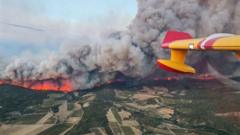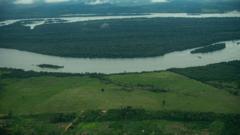**The Great Barrier Reef has recorded its worst coral cover loss in decades, raising urgent calls for climate action.**
**Catastrophic Coral Decline Strikes Great Barrier Reef**

**Catastrophic Coral Decline Strikes Great Barrier Reef**
**Unprecedented loss of coral threatens one of Earth's most vital ecosystems.**
The Great Barrier Reef has experienced its most significant annual decline in coral cover since monitoring began nearly four decades ago, according to a recent report from the Australian Institute of Marine Science (AIMS). Both the northern and southern sections of the reef have been subjected to the most severe coral bleaching events on record.
In the last few months, the reef has been battered by tropical cyclones and a surge in crown-of-thorns starfish populations, known for their voracious appetite for coral. However, AIMS identifies climate change-driven heat stress as the central culprit behind the coral's perilous state. The report warns of an impending tipping point, beyond which coral may not recover rapidly enough between devastating episodes, leaving the ecosystem in a precarious position.
AIMS conducted health surveys on 124 coral reefs between August 2024 and May 2025, following ongoing assessments since 1986. Sprawling across 2,300 kilometers, the Great Barrier Reef is often celebrated as the world's largest living structure, teeming with a rich biodiversity. Unfortunately, repeated bleaching events have rendered vast areas of once-lush coral stark white.
Interestingly, this year marks a significant first: Australia's second-largest reef, Ningaloo, also experienced extensive bleaching simultaneously with its eastern counterpart for the first time. Coral formations play a critical role in sustaining marine life, acting as habitats for approximately 25% of all ocean species. Coral bleaching occurs when temperature increases stress the coral, leading to a white appearance.
Although coral can recover from heat stress, it requires several years of favorable conditions to regenerate. If water temperatures rise just 1°C above the coral’s thermal limit for two months, the coral is likely to perish; at 2°C warmer, survival drops to about a month. The Great Barrier Reef's recent bleaching events are reported as the sixth major occurrence since 2016, exacerbated by consistently warm waters.
The conditions prompted a bleak assessment, stating the reef has absorbed "unprecedented levels of heat stress" and experienced the largest area and severity of bleaching on record. Future recovery hinges on essential coral repopulation efforts and stabilization of environmental disturbances.
Among the coral species most affected is the Acropora, a group known for rapid growth but significant vulnerability to heat stress and predation by crown-of-thorns starfish. Dr. Mike Emslie, the AIMS research lead, emphasized the urgency of preserving the Great Barrier Reef, calling it a "beautiful, iconic place" worthy of protection and reiterating its potential to bounce back if given sufficient chance.
Significant strides have been made through the Australian government's crown-of-thorns starfish control program, which has successfully eliminated over 50,000 starfish. Recent AIMS findings indicated no severe outbreaks of these coral-eating creatures in the Central Great Barrier Reef in 2025.
Nevertheless, Richard Leck from WWF warned that without ambitious climate action, the Great Barrier Reef might face the same dire fate as other coral ecosystems worldwide, which are already on the verge of collapse. Despite its heritage listing for over 40 years, UNESCO has called attention to the Australian reef being "in danger" due to rising water temperatures and pollution threats.




















